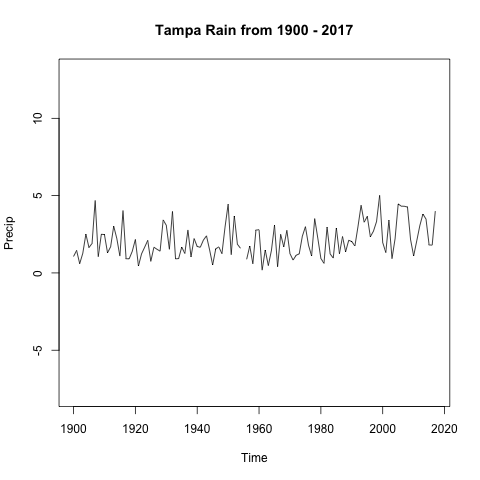This week's topics covered time-series analysis and smoothing techniques of time-series data.
Question # 1 : Apply the procedures outlined in the assignment details to the Tampa weather data and create a report involving hypotheses.
Null hypothesisH0: The average annual precipitation of the data set shows a linear upward trend.
Alternative hypothesis
H1: The average annual precipitation of the data set does not show a linear upward trend.
#Install library to handle .xlsx files
> install.packages("readxl")
> library(readxl)
#Import provided data
> tampaweather <- read_excel("tampadata.xlsx", sheet=1)
#Separate precipitation column for analysis
#Values for year will be input via time series object
> tamparain <- tampaweather[,9]
#Convert data to time series object
> tampaprecip.ts <- ts(tamparain, freq=1, start=1900)
Warning message:
In data.matrix(data) : NAs introduced by coercion
#Account for values of 'NA'
> is.na(tampaprecip.ts) <- 0
#Print time series
> print(tampaprecip.ts)
Time Series:
Start = 1900
End = 2017
Frequency = 1
Precip
[1,] 1.06
[2,] 1.45
[3,] 0.60
[4,] 1.27
[5,] 2.51
[6,] 1.64
[7,] 1.91
[8,] 4.68
[9,] 1.06
[10,] 2.50
[11,] 2.48
[12,] 1.30
[13,] 1.69
[14,] 3.02
[15,] 2.23
[16,] 1.09
[17,] 4.03
[18,] 0.92
[19,] 0.91
[20,] 1.40
[21,] 2.16
[22,] 0.45
[23,] 1.23
[24,] 1.66
[25,] 2.10
[26,] 0.75
[27,] 1.66
[28,] 1.53
[29,] 1.41
[30,] 3.43
[31,] 3.08
[32,] 1.53
[33,] 3.97
[34,] 0.91
[35,] 0.93
[36,] 1.67
[37,] 1.26
[38,] 2.78
[39,] 1.04
[40,] 2.22
[41,] 1.71
[42,] 1.66
[43,] 2.12
[44,] 2.40
[45,] 1.50
[46,] 0.52
[47,] 1.56
[48,] 1.68
[49,] 1.25
[50,] 2.96
[51,] 4.44
[52,] 1.19
[53,] 3.68
[54,] 1.86
[55,] 1.59
[56,] NA
[57,] 0.88
[58,] 1.74
[59,] 0.60
[60,] 2.77
[61,] 2.79
[62,] 0.18
[63,] 1.48
[64,] 0.48
[65,] 1.45
[66,] 3.08
[67,] 0.41
[68,] 2.49
[69,] 1.69
[70,] 2.75
[71,] 1.25
[72,] 0.83
[73,] 1.14
[74,] 1.24
[75,] 2.37
[76,] 2.99
[77,] 1.79
[78,] 1.10
[79,] 3.51
[80,] 2.25
[81,] 0.94
[82,] 0.62
[83,] 2.96
[84,] 1.23
[85,] 0.96
[86,] 2.90
[87,] 1.25
[88,] 2.35
[89,] 1.37
[90,] 2.11
[91,] 2.03
[92,] 1.74
[93,] 3.00
[94,] 4.37
[95,] 3.28
[96,] 3.66
[97,] 2.34
[98,] 2.70
[99,] 3.32
[100,] 5.01
[101,] 1.96
[102,] 1.32
[103,] 3.41
[104,] 0.93
[105,] 2.22
[106,] 4.46
[107,] 4.32
[108,] 4.31
[109,] 4.26
[110,] 2.16
[111,] 1.10
[112,] 2.07
[113,] 3.06
[114,] 3.81
[115,] 3.48
[116,] 1.81
[117,] 1.80
[118,] 4.00
#Give the chart file a name
> png(file = "tampaprecip.png")
#Plot a graph of the time series
> plot(tampaprecip.ts, asp=5, main = "Tampa Rain
from 1900 - 2017")
#Save the file
> dev.off()

Based on the results from the time series visualization, there appears to be a slight linear trend in the upward direction. Therefore, we accept the null hypothesis. It is worth noting that a forecast line would smooth the line graph and more clearly show if a trend is apparent, however, this was unable to be applied to the time series.
Note: I attempted to add a forecast line using exponential smoothing via the HoltWinters function per the Avril Coghlan text, however I kept receving an error saying I had values of NA even though I had removed them. I was unable to resolve this error.
> precipforecasts <- HoltWinters(tampaprecip.ts,
beta=FALSE, gamma=FALSE)
Error in hw(p, beta, gamma) : NA/NaN/Inf in
foreign function call (arg 1)
